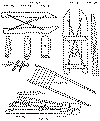By Dan Beard
[Follow Hyperlinks Above]
A Raft that will Sail

Fig. 181.
The Man-Friday Raft Scudding Before the Wind.
First we will select two pine logs of equal length, and, while the water is heating for our coffee we will sharpen the butt or larger end of the logs on one side with the axe, making a "chisel edge," as shown in Fig. 171. This gives us an appetite for breakfast and makes the big fish in the lake, as they jump above the water, cast anxious looks toward our camp.

Figs. 171-179.
Parts of Man-Friday Sailing Raft.
Fig. 171--Logs in Place with Braces. Figs. 172, 173, 174--Struts. Fig. 175--Pegs. Fig. 176--Raft with Middle and Stern Strut in Place. Fig. 177--Springs for Dry Deck. Fig. 178 Dry Deck. Fig. 179--Dry Deck in Place
Breakfast finished, we will cut some cross-pieces to join our two logs together, and at equal distances apart we will bore holes through the cross-pieces for peg-holes (Figs. 172, 173, and 174). While one of the party is fashioning a number of pegs, each with a groove in one side, like those shown in Fig. 175, the others will roll the logs into the water and secure them in a shallow spot.
Shoes and stockings must be removed, for most of the work is now to be done in the water. Of course, it would be much easier done on land, but the raft will be very heavy and could never be launched unless under the most favorable circumstances. It is better to build the craft in the element which is to be its home.
Cut two long saplings for braces, and after separating the logs the proper distance for your cross-pieces to fit, nail your braces in position, as represented by Fig. 171.
This holds the logs steady, and we may now lay the two cross-pieces in position and mark the points on the logs carefully where the holes are to be bored to correspond with the ones in the cross-pieces. Bore the holes in one log first; make the holes deep enough and then fill them with water, after which drive the pegs through the ends of the cross-pieces and into the tog. The grooves in the pegs (Fig. 175) will allow the water to escape from the holes and the water will cause the peg to swell and tighten its hold on the log and cross-pieces.
Now bore holes in the other log under those in the cross-pieces and fill them with water before driving the pegs home, as you did in the first instance. Fig. 176 is a Man-Friday raft.